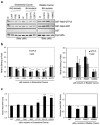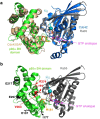Patient-derived mutations within the N-terminal domains of p85α impact PTEN or Rab5 binding and regulation
- PMID: 29740032
- PMCID: PMC5940657
- DOI: 10.1038/s41598-018-25487-5
Patient-derived mutations within the N-terminal domains of p85α impact PTEN or Rab5 binding and regulation
Abstract
The p85α protein regulates flux through the PI3K/PTEN signaling pathway, and also controls receptor trafficking via regulation of Rab-family GTPases. In this report, we determined the impact of several cancer patient-derived p85α mutations located within the N-terminal domains of p85α previously shown to bind PTEN and Rab5, and regulate their respective functions. One p85α mutation, L30F, significantly reduced the steady state binding to PTEN, yet enhanced the stimulation of PTEN lipid phosphatase activity. Three other p85α mutations (E137K, K288Q, E297K) also altered the regulation of PTEN catalytic activity. In contrast, many p85α mutations reduced the binding to Rab5 (L30F, I69L, I82F, I177N, E217K), and several impacted the GAP activity of p85α towards Rab5 (E137K, I177N, E217K, E297K). We determined the crystal structure of several of these p85α BH domain mutants (E137K, E217K, R262T E297K) for bovine p85α BH and found that the mutations did not alter the overall domain structure. Thus, several p85α mutations found in human cancers may deregulate PTEN and/or Rab5 regulated pathways to contribute to oncogenesis. We also engineered several experimental mutations within the p85α BH domain and identified L191 and V263 as important for both binding and regulation of Rab5 activity.
Conflict of interest statement
The authors declare no competing interests.
Figures






Similar articles
-
Impact of p85α Alterations in Cancer.Biomolecules. 2019 Jan 15;9(1):29. doi: 10.3390/biom9010029. Biomolecules. 2019. PMID: 30650664 Free PMC article. Review.
-
The p85alpha subunit of phosphatidylinositol 3'-kinase binds to and stimulates the GTPase activity of Rab proteins.J Biol Chem. 2004 Nov 19;279(47):48607-14. doi: 10.1074/jbc.M409769200. Epub 2004 Sep 16. J Biol Chem. 2004. PMID: 15377662
-
Identification of mutations in distinct regions of p85 alpha in urothelial cancer.PLoS One. 2013 Dec 18;8(12):e84411. doi: 10.1371/journal.pone.0084411. eCollection 2013. PLoS One. 2013. PMID: 24367658 Free PMC article.
-
Direct positive regulation of PTEN by the p85 subunit of phosphatidylinositol 3-kinase.Proc Natl Acad Sci U S A. 2010 Mar 23;107(12):5471-6. doi: 10.1073/pnas.0908899107. Epub 2010 Mar 8. Proc Natl Acad Sci U S A. 2010. PMID: 20212113 Free PMC article.
-
Multiple roles for the p85α isoform in the regulation and function of PI3K signalling and receptor trafficking.Biochem J. 2012 Jan 1;441(1):23-37. doi: 10.1042/BJ20111164. Biochem J. 2012. PMID: 22168437 Review.
Cited by
-
Conformationally active integrin endocytosis and traffic: why, where, when and how?Biochem Soc Trans. 2020 Feb 28;48(1):83-93. doi: 10.1042/BST20190309. Biochem Soc Trans. 2020. PMID: 32065228 Free PMC article. Review.
-
Impact of p85α Alterations in Cancer.Biomolecules. 2019 Jan 15;9(1):29. doi: 10.3390/biom9010029. Biomolecules. 2019. PMID: 30650664 Free PMC article. Review.
-
Insight into the PTEN - p85α interaction and lipid binding properties of the p85α BH domain.Oncotarget. 2018 Dec 11;9(97):36975-36992. doi: 10.18632/oncotarget.26432. eCollection 2018 Dec 11. Oncotarget. 2018. PMID: 30651929 Free PMC article.
-
Cancer-associated mutations in the p85α N-terminal SH2 domain activate a spectrum of receptor tyrosine kinases.Proc Natl Acad Sci U S A. 2021 Sep 14;118(37):e2101751118. doi: 10.1073/pnas.2101751118. Proc Natl Acad Sci U S A. 2021. PMID: 34507989 Free PMC article.
-
The orchestrated signaling by PI3Kα and PTEN at the membrane interface.Comput Struct Biotechnol J. 2022 Oct 7;20:5607-5621. doi: 10.1016/j.csbj.2022.10.007. eCollection 2022. Comput Struct Biotechnol J. 2022. PMID: 36284707 Free PMC article. Review.
References
Publication types
MeSH terms
Substances
Grants and funding
LinkOut - more resources
Full Text Sources
Other Literature Sources
Research Materials
Miscellaneous

